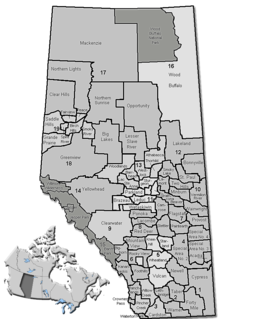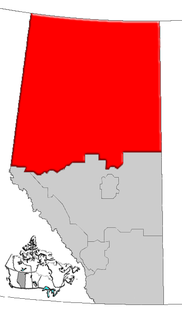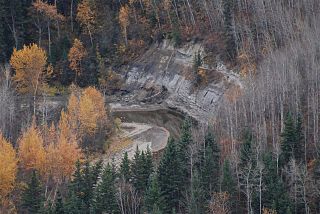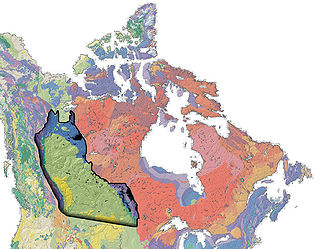
Peace River, originally named Peace River Crossing, and known as Rivière-la-Paix in French, is a town in northwestern Alberta, Canada, situated along the banks of the Peace River, at its confluence with the Smoky River, the Heart River and Pat's Creek. It is located 486 kilometres (302 mi) northwest of Edmonton, and 198 kilometres (123 mi) northeast of Grande Prairie, along Highway 2. It was known as the Village of Peace River Crossing between 1914 and 1916.

Whitecourt is a town in central Alberta, Canada within Woodlands County. It is located approximately 177 km (110 mi) northwest of Edmonton and 279 km (173 mi) southeast of Grande Prairie at the junction of Highway 43 and Highway 32, and has an elevation of 690 m (2,260 ft). The Whitecourt meteor impact crater is found on nearby Whitecourt Mountain.

Tawatinaw is a hamlet in Alberta, Canada within Westlock County. It is located on Township Road 614, 2 kilometres (1.2 mi) east of Highway 2 and approximately 70 kilometres (43 mi) north of the City of Edmonton.

St. Isidore is a hamlet in northwest Alberta, Canada, within Northern Sunrise County. It is located approximately 16 kilometres (9.9 mi) east of the Town of Peace River on Range Road 204 off Highway 688. St. Isidore is flanked by deep ravines cut by Pat's Creek to the north and Pat's Creek tributary to the south. The ravines are surrounded by pine forests.

The County of Vermilion River is a municipal district located in the eastern part of central Alberta, Canada in Census Division #10. The municipal district was formerly named the County of Vermilion River No. 24 prior to an official name change that became effective on September 13, 2006.

Wabasca, also known as Wabasca-Desmarais, is a hamlet in northern Alberta, Canada, within the Municipal District of Opportunity No. 17. It is located between and along the South and North Wabasca Lakes, at the intersection of Highway 813 and Highway 754. It is approximately 123 kilometres (76 mi) northeast of Slave Lake.

Cadotte Lake is an unincorporated community in northern Alberta, Canada within Northern Sunrise County. It is located on the northern shore of the homonymous lake, along Highway 986, 79 km (49 mi) east of Peace River and 68 km (42 mi) west of the Bicentennial Highway.

Brownfield is a hamlet in central Alberta, Canada within the County of Paintearth No. 18. It is located approximately 25 km (16 mi) north of Highway 12 and 122 km (76 mi) southeast of Camrose. It is only a few miles south from the Battle River and positioned along Highway 872.

Little Buffalo is a hamlet in northern Alberta, Canada within Northern Sunrise County. It is located on Highway 986, approximately 100 kilometres (62 mi) northeast of the Town of Peace River and 47 kilometres (29 mi) west of Highway 88. Little Buffalo Lake is to the south of the community.

Marie Reine is a hamlet in northwest Alberta, Canada within Northern Sunrise County. It is located approximately 18 km (11 mi) south of the Town of Peace River on four quarter sections split by Highway 744.

Notikewin is a hamlet in northern Alberta, Canada within the County of Northern Lights.

Reno is a hamlet in northern Alberta, Canada within Northern Sunrise County. It is located 8 kilometres (5.0 mi) east of Highway 2, approximately 146 kilometres (91 mi) northeast of Grande Prairie. It is probably named after Reno, Nevada.

St. Lina or Ste-Lina in French, is a hamlet in northern Alberta, Canada within the County of St. Paul No. 19. It is home of St. Lina Community Hall. It is located approximately 14 kilometres (8.7 mi) north of Highway 28 and 85 kilometres (53 mi) southwest of Cold Lake.
The Woodland Cree First Nation is a First Nation in Alberta, Canada adjacent to the Cadotte Lake in Northern Sunrise County northeast of the Town of Peace River. The hamlet of Cadotte Lake is located within the reserve.

Three Creeks is an unincorporated community in northern Alberta, Canada.











